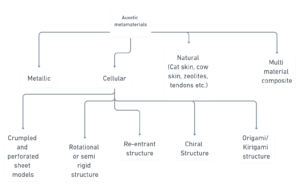Architected Materials: Metamaterials
Metamaterials are those materials that are not found in nature and are artificially manufactured materials. The properties of such materials are derived from their internal microstructure (geometrical configuration) and not from their chemical composition. The concept of metamaterials was initially coined in the context of optics and electromagnetism.
The properties of the metamaterials on the macro-scale level are due to the nano/micro architecture of such materials. So, metamaterials are designed at the nano/micro scale to obtain desired unusual properties. Since metamaterials are artificially made materials, but some of them are also found in nature like ‘morpho’ butterfly wings, silk fiber, etc.
In a broad sense, there are generally the following types of metamaterials:
-
Mechanical metamaterials
-
Electromagnetic metamaterials
-
Acoustic metamaterials
-
Optical metamaterials
-
Thermal metamaterials
-
Combination of the above
Mechanical metamaterials (Auxetics metamaterials):
-
Mechanical metamaterials belong to the important class of metamaterials having unique mechanical properties that are dependent on the elastic constants like elastic modulus, shear modulus, bulk modulus, Poisson’s ratio, etc.
-
Mechanical metamaterials possess unusual mechanical properties like negative Poisson’s ratio (Auxetics metamaterials), negative elasticity, and negative compressibility.
-
Auxetics Metamaterials are those metamaterials having a negative Poisson’s ratio. Such materials possess various unusual properties like high shear resistance, indentation resistance, fracture resistance, better energy absorbance, synclastic behavior, variable permeability, etc.
-
Auxetic metamaterials are used in various areas like- a) Sports industry b) Medical industry c) Sensors and actuators d) Textiles e) Defence f) Aerospace sector g) Protective devices h) Auxetic nails
The general classification of auxetic metamaterials is given as:
